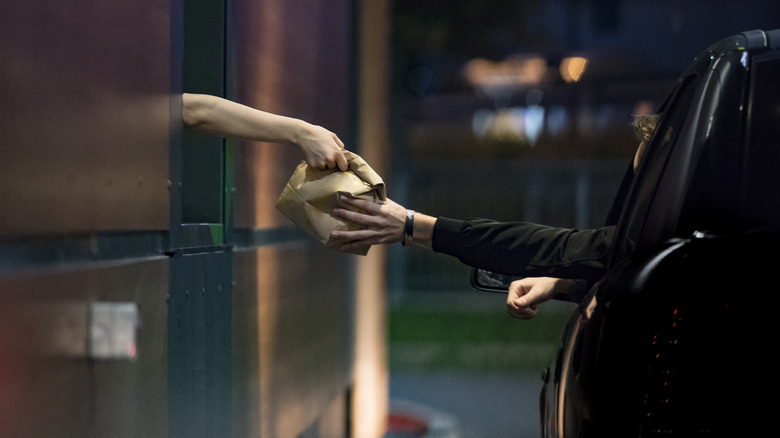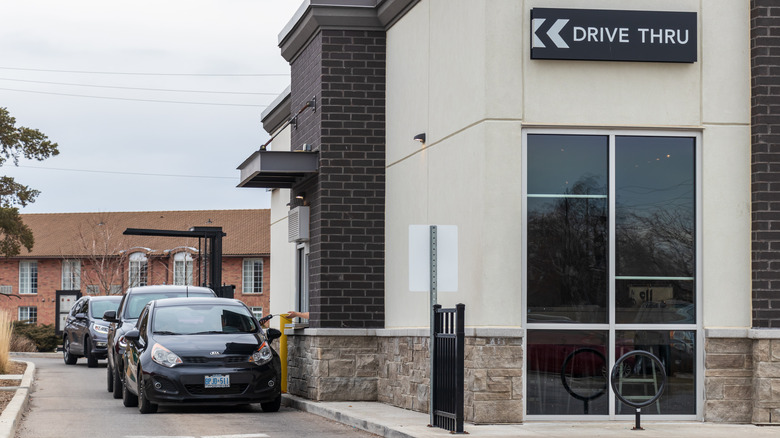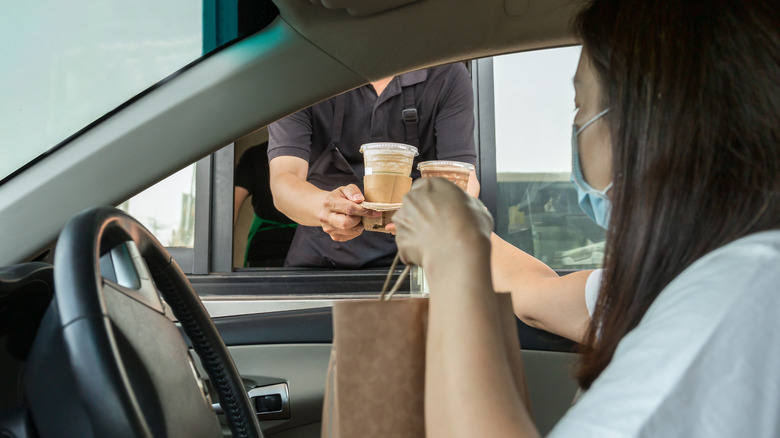Fed-Up Cities Are Trying To Put A Stop To New Drive-Thrus
Drive-thrus are a crucial part of many restaurants' sales, helping to make the "fast" part of "fast food" a reality. At McDonald's, the drive-thru accounts for at least 70% of total sales. But, what happens when drive-thrus become more of a nuisance than a convenience? In major cities across the U.S., that's exactly what's happening as an overflow of cars spill out from drive-thru corrals and onto the streets.
Sprawling drive-thru lines stop traffic, stop people from walking on sidewalks and cycling in bike lanes, and block foot traffic to neighboring businesses. They're also a serious threat to pedestrian safety, and it's already been a pretty grisly scene for U.S. pedestrians across the board lately. 2022 saw the highest number of traffic-related pedestrian fatalities since 1981. Drive-thrus are also often located off of major highways and important traffic regions to attract attention, but excessive lines can block the flow of traffic in crucial through-ways and on-ramps. (Hello, fender bender.)
Urban planning doesn't account for this amount of traffic, and it's consistently exacting a significant negative impact on the everyday goings-on of surrounding communities. Now, this upcoming August, the Atlanta City Council is scheduled to vote on a bill that would effectively ban any new drive-thru constructions in the area. Salt Lake City, Pittsburgh, and Mesa, Arizona are also considering similar legislation, reports CNN Business. Other major cities have already passed drive-thru construction bans, including Orchard Park, NY, Fair Haven, NJ, and Minneapolis, MO.
A threat to pedestrians and small businesses
The convenience of remaining in your car is universally attractive, but drive-thrus were especially important (or, should we say essential?) during the height of the COVID-19 pandemic when they allowed guests to minimize exposure. This popularity, coupled with their lower cost of operation compared to in-person dining, led to increased drive-thru construction.
Today, America is home to roughly 200,000 drive-thrus, per CNN Business, which receive an estimated 6 billion customers every single year — and this isn't the first time excessively long lines have caused trouble. In December 2020, Toledo business owner Mario Kiezi filed a lawsuit against a neighboring Chick-fil-A after its drive-thru line regularly stretched into Kiezi's parking lot, blocking parking spaces and, in some cases, preventing people from exiting the lot altogether.
Not only is this scene unsavory, but it also carries the implication that large-chain fast-food restaurants could potentially choke out nearby mom-and-pop businesses in the community. It doesn't look like lines are going to get shorter any time soon without major industry reform, either. QSR reports that customers are okay with waiting for up to 13 minutes in a drive-thru line. The average wait time was 11 minutes in 2021, compared to 9 minutes the year before, and 7 minutes the year before that. (All those idling cars are bad news for the environment, too.) So, what can consumers and small business owners expect going forward?
The future of the drive-thru
Some businesses have inadvertently offered potential solutions. Last month, Panera launched a drive-thru pickup lane for mobile orders, perhaps the most efficient idea yet for reducing congestion and wait times. McDonald's and Taco Bell have been testing new AI drive-thru ordering systems that could similarly speed up the process.
Drive-thrus aren't being constructed to suit the immediate environment; they're just plopped down and the community has to adapt around the building. In the future, drive-thru restaurants might be more intentionally designed around the existing traffic flow of the area. Similar issues have surfaced with New York City's suddenly-booming al fresco dining scene, as hundreds of outdoor dining structures were constructed in the streets during the pandemic. Now, however, as restrictions ease and the large structures remain, New Yorkers are facing even worse traffic than normal as the dining structures occupy a house-sized chunk of busy streets. The city had torn down 169 of them as of January.
These potential and already-approved bills temporarily banning new drive-thru construction will certainly buy policymakers some time to figure out the best way to curb this nationwide problem. For urban planners wanting to structure communities in a way that encourages more walkability and protects local businesses, these reformations will be vital.


